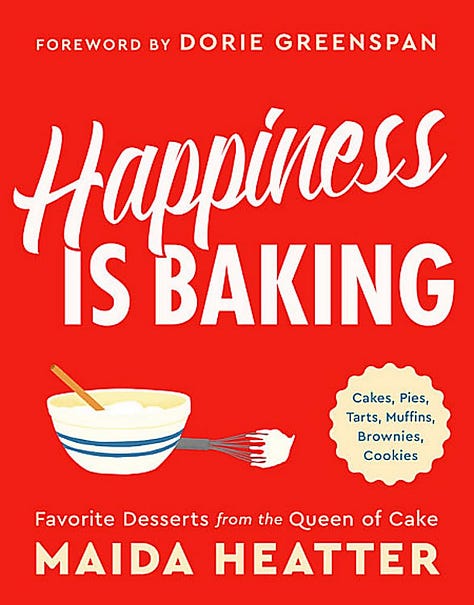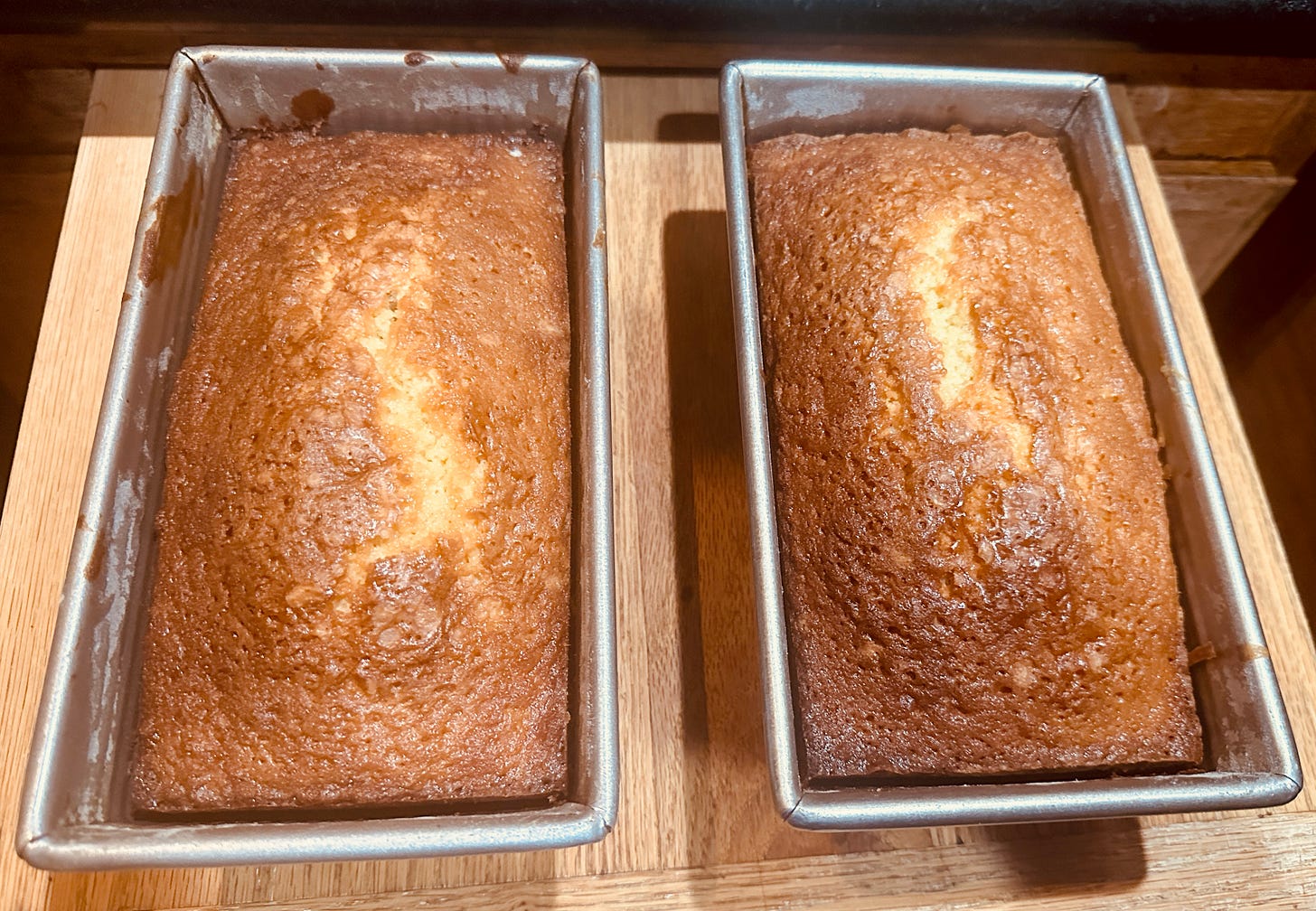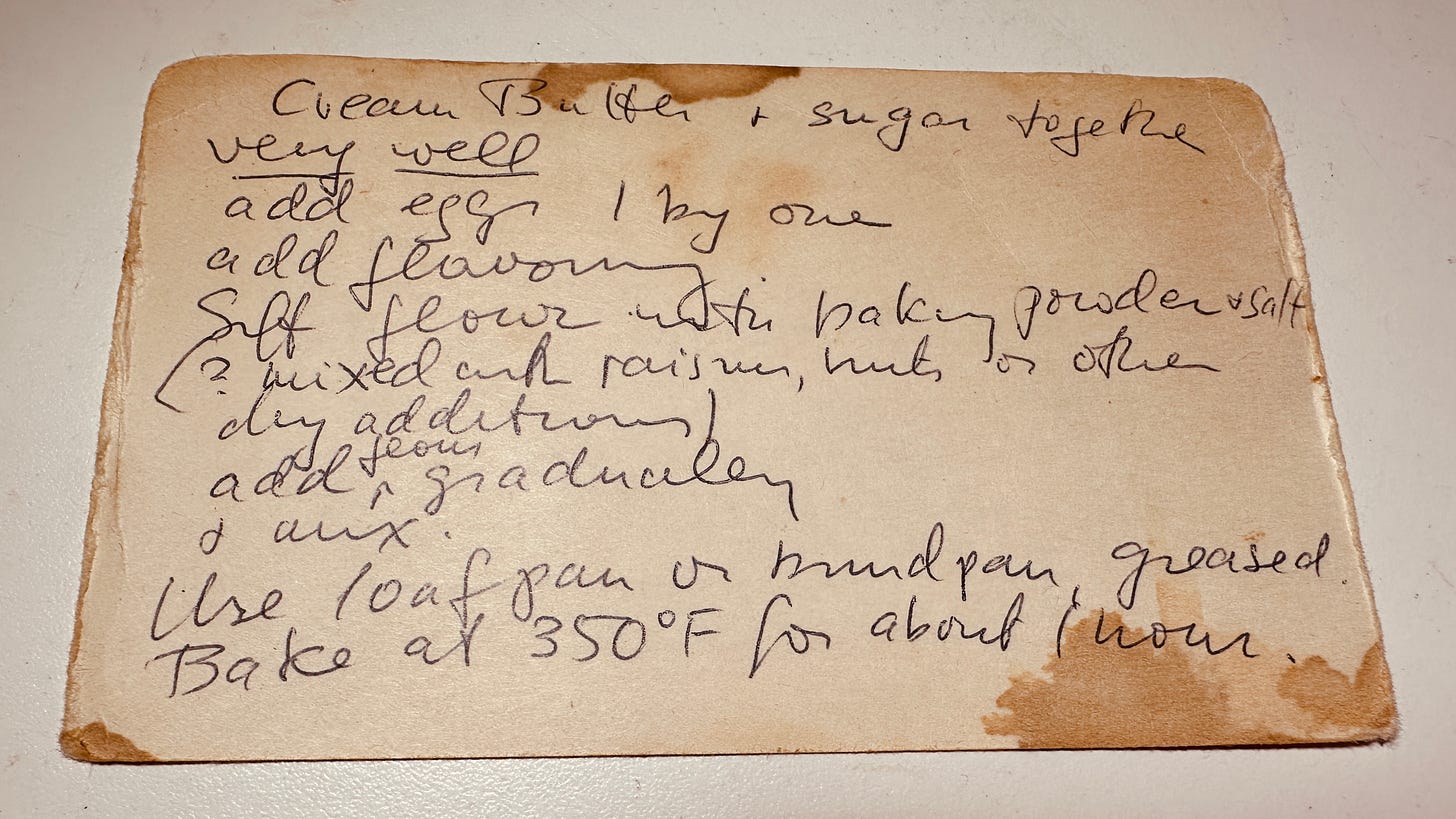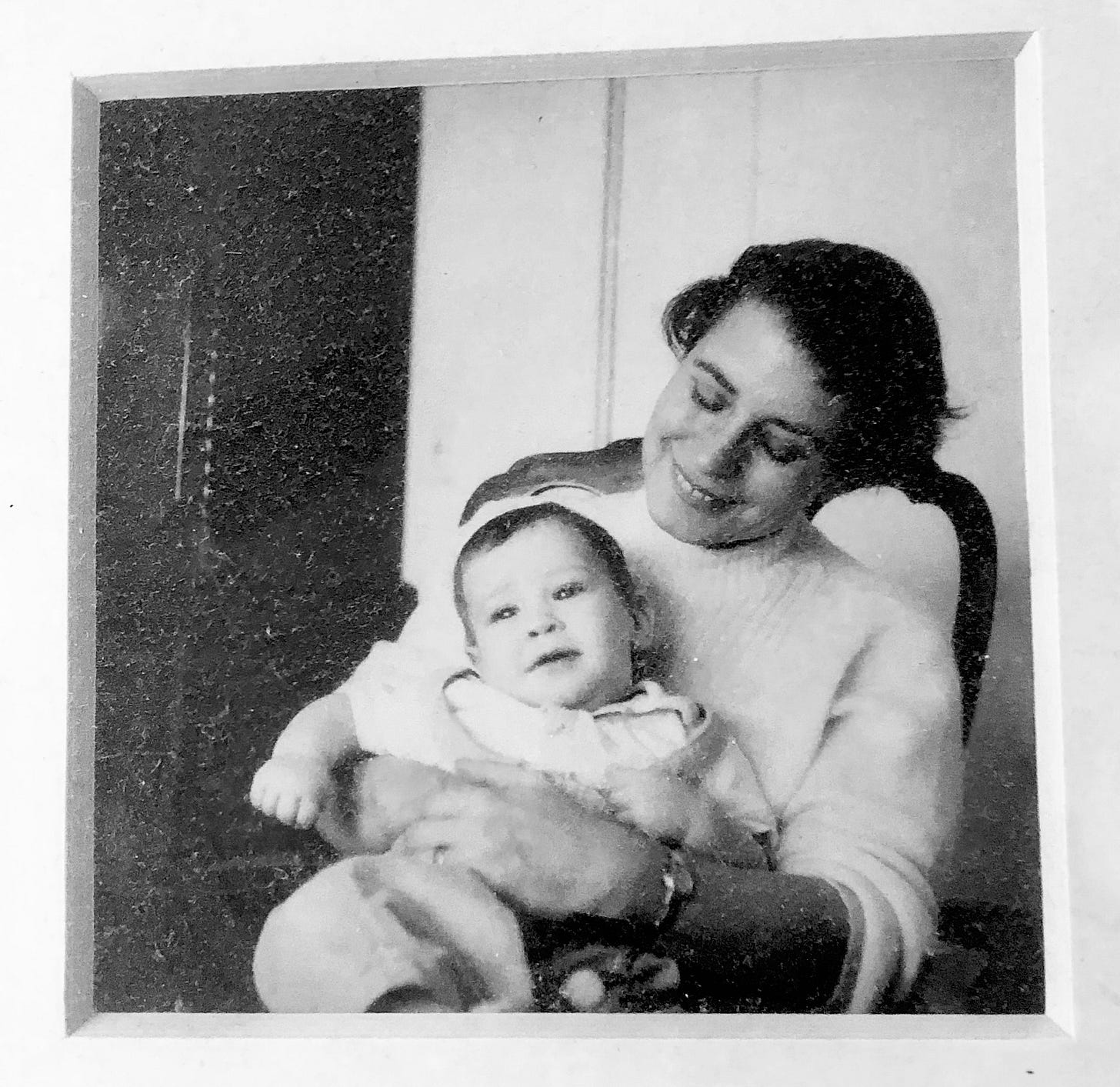Midnight 🎇 Cake Therapy
Late-night baking session, much loved pound cake summon sweet memories
I'm Ruth of RuthTalksFood, a newsletter about my love of food and the stories that come with it. These often involve family, friends, travel and recipes. RFT is always free and has been since it started almost four years ago. If you're new here, thanks so much for reading! Won’t you please do me a favor and click the subscribe button? That's free too.

I’m obsessed with pound cake. It’s the pastry my mother Flora, a Scottish-born lass with a love of baking, made most often. I remember her creaming the butter and sugar in the Harvest Gold-colored KitchenAid mixer of which she was so proud. She served slices of the cake for dessert or afternoon tea to company or at family gatherings.
The recipe appears on the first page of a tattered and stained notebook full of recipes that I inherited. When my late cousin Dan gifted me a box of cards filled with recipes from his mother, my Aunt Gerda (you can read my piece about Gerda here), I discovered a card in the box that also had that same pound cake recipe, with a couple of slight variations—a half teaspoon of mace and other add-ins like raisins and nuts in place of my mother’s favorite, crystallized ginger.1

When my Aunt Gerda’s daughter Margalit was visiting me recently, she said the cake she remembered her mother making most often was a sour cream coffee cake—something my mother also baked. You can read about that very cake in a guest post I wrote that appeared in Jolene Handy’s superb newsletter, Time Travel Kitchen, in late 2021. After reading the one below, be sure to read Jolene’s other posts, including her latest on the fascinating history of the Pullman loaf pan, named for the famous train cars!
A year or two ago, I made the pound cake as written in my mother’s notebook, guessing at her sketchy measurements (i.e., “1 cup sugar [nearly]”). I expected the first taste to lead to a “Madeleine moment,” one that, like the morsel of cookie dipped in tea that summoned the world of his childhood for Marcel Proust in his famous novel, In Search of Lost Time (En recherche du temps perdu), would bring my petite maman and her kitchen back to life. Well, of course it didn’t. The cake was a little bit disappointing—too dense and buttery for my taste. Was my mother’s version really so great or was it blind nostalgia that lofted it to unreasonable heights in my imagination? Or did I simply screw it up?
I didn’t try making it again for a while. But then one late night after a series of unfortunate events—a plumbing disaster leading to an impromptu bathroom remodel, a failed washing machine that nearly started a fire, and a fraud alert on my credit card while paying for expenses incurred by this chain of mishaps—I had the sudden inspiration in the middle of the night to make another pound cake, this time with a different recipe from a book I’d just ordered and received after reading a Valentine’s Day column from one of my favorite food writers, Dorie Greenspan.
In it, she mentioned the final cookbook by the late great Maida Heatter, who passed away in 2019 at the age of 102. Published that same year, Happiness Is Baking: Cakes, Pies, Tarts, Muffins, Brownies, Cookies: Favorite Desserts from the Queen of Cake, is a compilation of some of Heatter’s best-loved recipes. Even though Greenspan didn’t know the woman she calls “the baking goddess,” she said Heatter’s books helped turn her into a baker, beginning when she was grad student and would come home each evening to try her hand at making another Maida Heatter cake or cookie.
The instructions in Heatter’s recipes “were so good, so complete, and so meticulous and superbly thought out that it was easy to follow her and right to trust her. … I had the feeling she was cheering me on,” Greenspan wrote in the forward to Heatter’s last book.
My mother must have thought so too, for I discovered a copy of one of Heatter’s books, Maida Heatter’s Book of Great Cookies, in the collection Mom bequeathed to me.



Leafing through Happiness Is Baking (the title deserves a T-shirt!), I wanted to make and eat every single recipe. How could you not? Just the pictures and the names of the baked goods evoke a Pavlovian response: “Positively-the-Absolutely-Best-Chocolate-Chip Cookies,” “The Best Damn Lemon Cake,” “Palm Beach Brownies With Chocolate-Covered Mints,” “Charlie Brown Ice Cream Sundaes.”
The book’s second recipe, “The King’s Pound Cake,” caught my attention. It sounded pretty close to my mother’s, with some key differences—namely, more eggs, a cup of heavy cream, and the use of cake flour. Maida’s headnotes said it was adapted from Elvis Presley’s favorite pound cake. “They say he often ate a whole one (or two) all by himself,” she wrote.
If it was good enough for Elvis, it ought to be good enough for me—though perhaps not if it triggered an Elvis-scale eating binge! I hoped I could resist.
A Note about Pound Cake:
Traditionally a pound cake was made with a pound each of butter, sugar, eggs and flour. The French word for pound cake, quatre-quarts, literally “four quarters,” expresses neatly the simplicity of this cake—basically equal weights of a quartet of key ingredients.
Below you can read an excellent piece about the cake by Jamie Schler. In it she lays out the formula, offers some fascinating historical background, and includes recipes for two French versions: a yogurt cake that uses an empty yogurt pot as a tool of measurement. Schler also discusses the various iterations of pound cake-like pastries that have popped up through the ages. Among these is the English plum cake, which included a similar proportions of the four main ingredients, but with the addition of “a ton of raisins and dried candied peel, very English, often macerated in rum.” That sounds a lot like fruitcake to me (my not-so-secret crush!) but also similar to the pound cakes my mother made— which almost always included dried or candied fruit!

Happiness is a warm pound cake!
When life gives you lemons, zest a few of them into a cake!
Nothing like household calamities or even the usual quota of daily annoyances to trigger a late-night baking session, especially when your brain refuses to switch off when the lights go out.
So that was me a week or so ago at around a quarter to midnight. I’d spied Maida Heatter’s pound cake recipe, the one Elvis loved. With a few tweaks, I thought it might be the one I was looking for. It was! Maybe it was the addition of a cup of heavy cream or the use of cake flour instead of all-purpose, but the cake was simple and delicious and evoked that little bird of a woman, the one I called Mom, who used to run around tirelessly in the kitchen and still does sometimes in my head.
Here’s Maida Heatter’s recipe with my notes about changes:
The King’s Pound Cake*
Makes two 10-inch loaf cakes**
8 ounces (2 sticks or 226 grams) unsalted butter
1/8 teaspoon mace
1/2 teaspoon salt (I used sea salt)
1 teaspoon baking powder
2 teaspoons vanilla extract
3 cups sugar
7 large eggs
3 cups sifted cake flour (about 9 ounces or 255 grams)***
1 cup (8 ounces) heavy cream
Zest of 1 lemon (optional)
1/2 cup diced candied (crystallized) ginger, raisins or nuts (optional)
Adjust the oven rack one-third up from the bottom of the oven and preheat the oven to 350 degrees. You need two loaf pans that should not be dark metal, which makes the cake too dark. They should each have at least a 7-cup capacity.**
Butter the pans and dust them with fine, dry bread crumbs or with flour to allow excess crumbs or flour to fall out. Alternately, line the bottom and sides of the pan with parchment paper, grease the parchment, then leave an overhang at each short end of the loaf to help remove the loaves.
In the large bowl of an electric mixer, beat the butter with the mace, salt, baking powder, and vanilla until mixed. Gradually add the sugar and beat for about 5 minutes. Then beat in the eggs one at a time, scraping the bowl with a rubber spatula and beating only until incorporated after each addition.
If you’re adding ginger, raisins, nuts or any other addition, first mix them with a tablespoon or two of the flour. This will hopefully prevent sinking—which happened to the ginger pieces that I mixed into one of the loaves with a fork once the batter was already in the pan!
Add half the flour and stir, folding it in with a large rubber spatula or beat on low to incorporate. Gradually add the cream and stir or beat on low speed to mix it in. Add the remaining flour (plus the mix-ins if using), stirring or beating until smooth.
Divide the batter between the two pans. Jiggle the pans just a little to slightly level the tops. (The cakes will level off during baking.)
Bake for 1 hour and 15 or 20 minutes—until the loaves begin to come away from the sides of the pans. If the cakes are browning too quickly, place a piece of foil loosely over the tops.
Allow the loaves to cool in the pans for 25 to 30 minutes. Then cover one pan with a cake rack. Turn cake and rack upside down, remove the pan. With your hands, very gently and carefully turn the loaf right side up. Do the same with the second loaf. (If you have used parchment, gently lift the cakes out of the pan with the paper “handles,” tip the loaves and gently peel off the paper from the bottom.)
Let the loaves cool on the racks.
Wrap the cooled cakes in plastic wrap or store in a large sealable plastic bag. The wrapped pound cakes will keep for several days at room temperature, for one week when refrigerated, or they can be frozen for up to two months.

Notes:
*Slightly adapted from Maida Heatter’s Happiness Is Baking: Cakes, Pies, Tarts, Muffins, Brownies, Cookies: Favorite Desserts from the Queen of Cake.
**Heatter’s recipe calls for two 10 x 3 3/4 x 3 1/4 inch pans, but as I didn’t have any that size, I subbed two 8 1/2 x 4 1/2 x 2 5/8 inch pans (King Arthur’s standard bread loaf pan size), but the l think a larger 9 x 5 x 3 inch pan might have been better. I believe it would also work in a 10-inch bundt pan, though there might be some batter left over for mini cakes after filling the pan about two-thirds full. The baking time would be different.
***I used Swan’s Down cake flour because that’s what I had on hand. It’s bleached and enriched, which wouldn’t be my usual choice, but it made for a more tender cake with a finer, more even “crumb.” King Arthur has an unbleached version. Sift the flour into the cup measure, then sweep off the excess with a flat knife. The weight of 3 cups of sifted Swan’s Down flour is about 255 grams—or about 9 ounces.
Remembering Michael
Two years ago on March 2, my younger brother Michael died at the age of 62. (You can read the obituary I wrote about him here.) While he was in the hospital fighting for his life, the Russians invaded Ukraine. That war, the largest attack on a European country since World War II, continues, along with the devastating war between Israel and Hamas in the Gaza Strip that began Oct. 7 following the Hamas-led attack in Southern Israel. Another divisive presidential election is only nine months away. The stakes couldn't be higher.
I think often of all that has happened in the world and in our lives since I lost my brother. He would have been as troubled as I am by these events, but we would have talked about family and found some reason to laugh, be hopeful, and plan a walk or a dinner. He often yo-yo’ed from dieting to overindulgence, as did (and do) I; we were, after all, from the same family. But anything that reminded Michael of our mom, especially when it came to food, would evoke a smile and a special gleam in his eyes. I know he would have liked a slice or two (or three!) of pound cake with ginger. I might have sent him home with some cake to share with his family, though I doubt it would have made it there, mostly likely getting devoured en route amid the frustrations of stop-and-start Los Angeles traffic.
Baby brother, I do miss you! I wonder if there’s ginger pound cake in the sky. Probably not—unless a restless little lady called Flora is making it!
Thanks again for being here, for commenting and subscribing. If you like what you read, please share it with a friend.
See you soon.
Ruth
I always called it candied ginger. Typically “crystallized” and “candied” are used interchangeably when applied to ginger, but when I googled the terms, I learned that candied refers to ginger stored in the simple syrup and crystallized ginger means the version cooked in the sweet syrup and rolled in sugar, which is what my mother used.











Never a truer phrase “happiness is baking”! It really does have a way of injecting some joy. And pound cake is such a favourite, simple cakes are so underrated, but I think some of the best.
Pound cake is one of the pleasures of life. This was a blast -- especially with the ginger option.